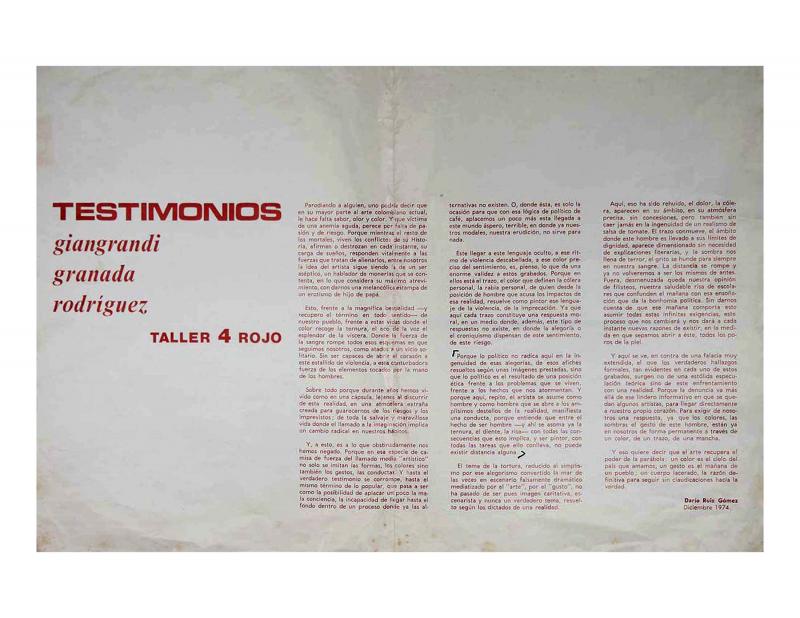This article is one of the few documents of the time that explains why the members of Taller 4 Rojo were interested in creating a school associated with their Taller de Artes Gráficas located in the La Candelaria section of Bogotá. Participants in the interdisciplinary Taller 4 Rojo, which was founded in 1974, included Diego Arango (b. 1942), Nirma Zárate (1936–99), Umberto Giangrandi (b. 1942), and Jorge Mora; the group disbanded in 1974 due to political differences between members. The group’s activities included producing original prints mostly of a political and narrative nature and propaganda material for the social movements active at the time. It also made posters and signs announcing events and exhibitions at cultural institutions in Bogotá such as the Museo de Arte Moderno and the Biblioteca Luis Ángel Arango.
The origin of this group lay in the widespread social dissatisfaction with the four administrations that held power in Colombia until 1974 as part of the Frente Nacional, a political alliance between the traditional Liberal and Conservative parties. Those administrations were characterized by deep-seated corruption and repression of any form of political opposition as well as a failure to heed the needs of impoverished sectors. Taller 4 Rojo was formed in the early seventies, a period when social movements were gaining strength; thanks to their rigorous organization, students were at the forefront of many such movements. Taller 4 Rojo was a venue in which to articulate political ideas in opposition to the administrations of Misael Pastrana Borrero (1970−74) and the early years of Alfonso López Michelsen (1974−78). On the basis of a notion of “the visual,” the group produced realistic images whose montage made use of photography. The group’s work dealt with the crucial issues of the day like the Vietnam War; some pieces made use of images of political icons such as María Cano (1887−1967), a leader of workers’ movements from the twenties, Manuel Quintín Lame (1880−1967), an indigenous figure who was a political prisoner in the twenties, and Camilo Torres (1929−66), a priest who, after dying while engaged in armed struggle with the ELN (National Liberation Army), became its martyr.
This text is closely tied to the following documents: “El debate queda abierto. ¿La clase intelectual participa en el cambio social o se beneficia con la miseria?” [doc. no. 1102659]; “Folleto del Taller Escuela de Artes Gráficas 4 Rojo” [doc. no. 1135790]; and “Testimonios: Giangrandi, Granada, Rodríguez” [doc. no. 1130853].



